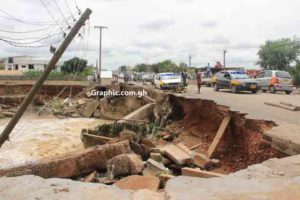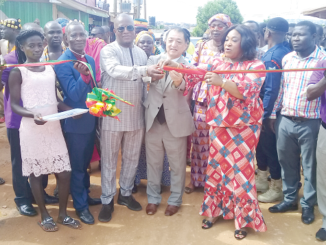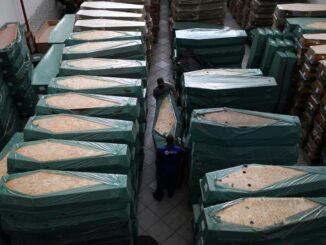 Six persons, including a female medical doctor and a two-month-old baby girl, lost their lives during a downpour in parts of Accra and Ho last Monday night.
Six persons, including a female medical doctor and a two-month-old baby girl, lost their lives during a downpour in parts of Accra and Ho last Monday night.
Identified as Eyan Oppong, the doctor, who was also a nursing mother, is said to have qualified as a medical officer recently and was waiting for her posting to do her housemanship.
The Hyundai Accent saloon car which was being driven by Dr Oppong, 33, who was returning home from an evening church service, was washed away by the flood waters at the Teshie Demo Bridge.
Two other persons who were in the car were rescued by some onlookers, but they could not save the doctor’s life, reports Emelia Enin Abbey.
The two-month-old baby girl drowned in a flooded house at Madina in Accra, while the body of an unidentified man was recovered from a drain at Trasacco in the downpour that lasted about seven hours.
In Ho, a grandmother and her two children were electrocuted while they were running away after the roof had been ripped from their kitchen.
Confirming the number of deaths in Accra, the Kpeshie Divisional Crime Officer, Superintendent of Police Mr Emmanuel Osei Agbogah, said the police received information about 11:30 p.m. last Monday that flood waters had carried away a woman in a car at the Teshie Demo Bridge.
He said some onlookers rescued two other persons on board the vehicle but their attempts to save Dr Oppong failed, as the force of the flood waters pulled her while she was behind the wheels.
As of 4 p.m. Tuesday, her body had not been found but her car was retrieved some metres away from the bridge.
In the case of the baby girl, the Public Relations Officer of the Accra Regional Police Command, Deputy Superintendent of Police (DSP) Mrs Affia Tenge, said the baby’s mother told the police that about 10:30 p.m. Tuesday, a Good Samaritan attempted to carry the baby to safety but he tripped and fell into an open drain, together with the baby.
Although the rescuer was able to save himself, he was not able to retrieve the baby, who was washed away by the floods.
The body of the baby had not been found as of the time of going to press, despite frantic efforts by a search team, including the police and some neighbours.
The body of an unidentified man was found by the East Legon Police Station lying naked in a drain with bruises on the body. The cause of his death is unknown but he is suspected to have drowned in the heavy floods.
Electrocution
From Ho, Kofi Atsivor reports that a family of three met their untimely death when they got electrocuted at Adzorkope, a community in the Morkordze Electoral Area in the South Tongu District during the downpour last Monday night.
The victims, Yaa Gayi, a woman said to be in her 60s, and her two grandchildren, Mawulolo Dofey and Morkporkpor Dofey, aged 10 and eight, respectively, got trapped on a fallen aluminium roofing sheet when they were rushing to their room to escape danger from their ripped-off kitchen roof during the rains.
Unknown to them, some of the roofing sheets were in contact with a live electric wire and the three were electrocuted when they came into contact with the sheets.
The Volta Regional Director of the National Disaster Management Organisation (NADMO), Mr Divine Bosson, who confirmed the incident to the Daily Graphic, said the victims were found dead in front of their room after the rain had subsided about 9 p.m.
He said the bodies had been retrieved and deposited at the South Tongu District Hospital morgue for autopsy.
Affected areas
Apart from the deaths, the heavy rains caused homes to be submerged in communities, including Adabraka, the Railway Quarters at Achimota, Dome, East Legon Hills, Haatso, Kaneshie, Kwabenya, Madina, Ablekuma, Adenta, Ofankor, Weija, Okponglo, Shiashie, West Legon, Odawna, Ofankor Old Barrier and Dobro.
As the rains pounded the communities, some residents evacuated their homes at midnight for fear of being trapped, while others reached out to NADMO to rescue them.
Adabraka
The Adabraka neighbourhoods of Odawna and Official Town, two areas notorious for flooding were not left out of the disaster, as streets were inundated by flood waters.
The overhead bridge on the Graphic Road became impassable as water gushed from all sides of the bridge.
East Legon Hills – Nanakrom bridge
The bridge at Nanakrom Junction which connects the Ashale Botwe School Junction to East Legon Hills was not passable last Monday night and early Tuesday morning due to the floods, writes Enoch Darfah-Frimpong.
The floods submerged the bridge and the road, forcing some commuters to sleep in their vehicles on either side of the bridge.
Those who were familiar with the Lakeside Estate road used that alternative route to link East Legon Hills, but that route was not without difficulty, as some portions of that road were also flooded.
Achimota
At the Railway Quarters at Achimota, firemen from the Ghana National Fire Service (GNFS) made efforts to rescue residents, some of whom refused to leave their homes for fear of losing their belongings, reports Seth J. Bokpe.
Parts of the rail line that runs through the community bent from the pressure from the water and tonnes of refuse.
A visit by the Daily Graphic to some affected areas such as Achimota Holland City showed residents were devastated, as they counted their losses and lined up their damaged belongings, including electrical appliances, mattresses, clothes and cooking utensils, writes Ken Osei.
Accra’s problem
According to experts, Accra, which is in a low-lying area, experienced flooding annually mainly because of the haphazard construction of houses, especially on water courses, the poor drainage system and poor waste management challenges.
The city experienced its worst natural disaster on June 3, 2013 when torrential rains caused floods that brought Accra to its knees, with an unimaginable loss of lives and destruction of properties.
More than 150 fatalities were reported in the aftermath of the floods in a disaster that has been described as the worst in the country’s history.
In 2011, floods in the country resulted in the death of more than 30 people nationwide, with 15 victims in Accra, in addition to the destruction of properties running into millions of cedis.
Similar incidents were recorded in 1968, 1995, 1997, 1999, 2001, 2010, 2013 and 2014.
–
Credit: Daily Graphic



